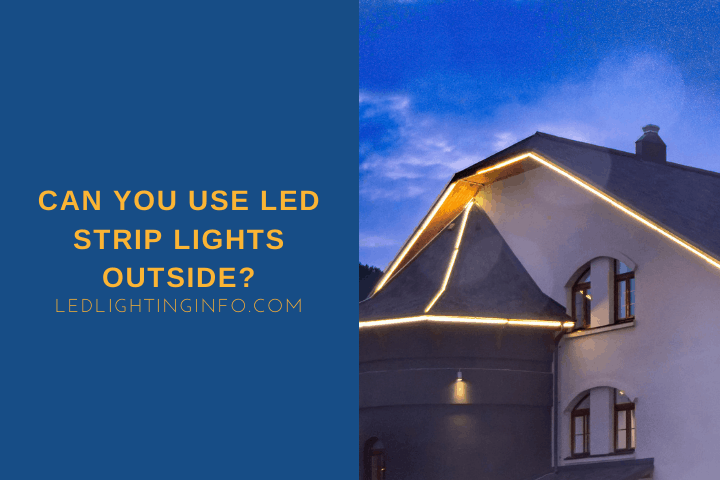LED strip lights are great for illuminating a space in your home. They’re bright, customizable, and flexible (literally) to fit around whatever alcove, furniture, or feature you want to light up.
But are they any good for use outdoors? Can you add LED strips to the exterior of your property safely?
Some LED strip lights are suitable to be used outdoors. You need to check the IP rating – 65 and above is waterproof. You also need to factor in outdoor fixings and whether the lights are too bright to be considered light pollution for your neighbors.
In this article I’m going to cover:
- Which LED lights are waterproof, if any
- How bright your outdoor lights should be
- How to safely and securely mount your strip lights outdoors
Are LED Strip Lights Waterproof and Weather Resistant?
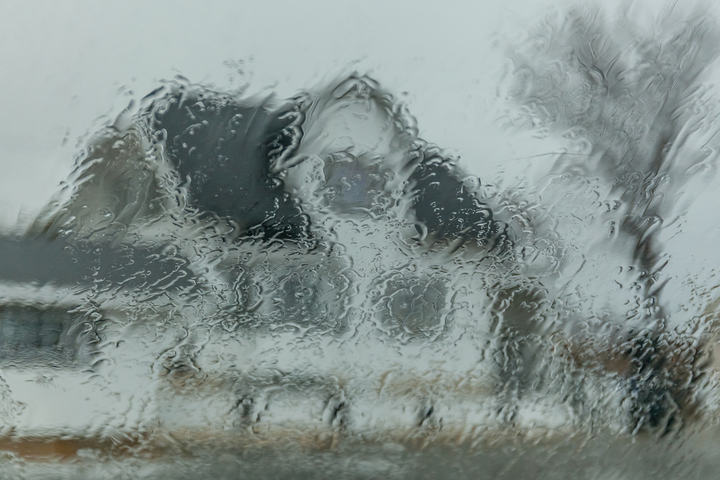
If you want to place an LED strip outside your home, you need to make sure that it’s safe.
Primarily, that means ensuring it’s waterproof because water is the easiest way for anything electrical to be damaged.
Water is conductive, which means that as soon as it gets into an electrical system, it creates connections that weren’t there before. So circuits are altered, power surges can occur, and they also become dangerous to handle.
So are all LED strips waterproof?
No, they aren’t, because making them waterproof means adding a special coating, or sealing them completely, which is more expensive.
Why make something that costs more when it might only be used indoors?
However, some strips are safe – you just need to find the right one. And for that, you can check the IP certification.
Ingress Protection Ratings Explained
Anything electrical should have an IP certification that explains how secure it is.
The IP rating is made up of two digits – the first relates to solid matter and runs from a scale of 0 (no protection) to 6 (dust-tight). The second refers to liquids and runs from 0 (no protection) to 9 (can withstand powerful, high-temperature water jets).
Indoor strip lights are typically rated IP20, which means that fingers (or finger-sized objects) can’t damage the circuits. Still, they aren’t protected from dust or liquids.
Spill water on your strip, and you’re in trouble. It’s why you must never install a strip indoors where you may have a damp problem.
Outdoor strip lights are normally rated IP65, which means they’re dust-tight and can withstand powerful water jets. However, they aren’t necessarily suited to immersion or high-temperature water.
It’s not about which brand you buy – many popular brands such as Philips Hue (Amazon) sell both indoor and outdoor strips.
You just need to make sure that you buy the correct type of strip for your needs, looking for that IP65 or better rating on the packaging or the website page where you’re buying it.
If in doubt about whether it’s legit, don’t buy it. Low prices mean cheap products, which make the product potentially dangerous.
Also, don’t think you can position a non-waterproof light strip in a sheltered position outside to protect it.
Unless it’s in a completely sealed space, you’re going to encounter problems with water splashing, or running down a surface. An awning doesn’t offer enough protection.
Problems With Ambient And Junction Temperature

Once you’ve taken water into account, you then need to consider temperature.
Obviously, it depends on where you live and your typical climate.
But you’ll be glad to know that if your home town is situated in a cooler part of the world, then you shouldn’t have any problems – LED lights excel in cold temperatures.
Typically, LED strips work in conditions between -22°F and 140°F, so well below the point of freezing.
Even during winter, your LED lights should have no trouble working. If anything, their lifetime will be preserved more as heat is more easily taken away from the bulb.
Christmas lights should last a very long time!
But what about if you live somewhere hot?
Those working temperatures refer to the junction temperature – the temperature of the individual components – not the ambient temperature in the air.
The junction temperature will be impacted not only by the climate but also by the material where you place the light strip and how exposed it is to direct sunlight.
Say you wanted to weave your light strip around your plants at the edge of your garden or wrap it around your decking.
Both surfaces absorb heat and are at a much higher temperature than the ambient air.
A sports study showed that, in ambient air temperatures of around 82°F, synthetic turf reached a maximum of 157°F.
Various decking materials can reach over 140°F too.
Say you live in Phoenix, Arizona – where the average LOW temperature during summer months is 83°F.
Then you’re going to need to protect your strip lights, making sure neither the LEDs themselves or the surface they’re attached to is in the sun.
To sum all of that up – are LED strip lights waterproof and weatherproof?
Not all of them – but buy an IP65 outdoor strip and make sure it’s kept out of direct sunlight, and you shouldn’t have any problems.
What Light Density Should Outdoor Strip Lights Have?
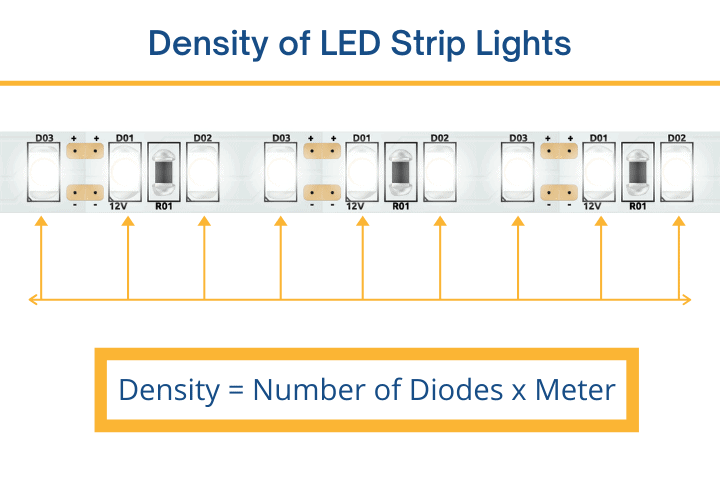
LED strips aren’t the same in terms of how many lights they feature or how bright they are.
Let’s start with density.
The more dense a strip, the more diodes it has, and therefore the brighter it is.
The standard density for a light strip is 30 bulbs per meter, but they can be much higher.
Strips with 60 or 120 bulbs per meter are common, but you can get strips with as many as 350 bulbs per meter if you really wanted to.
Obviously, the more bulbs per meter and the closer together they are, the brighter the strip will be, and you get a more uniform light.
Of course, they will then consume more power too.
And then let’s talk about the brightness of the diodes, which relates to the size. You’ll commonly find that LED strips are described as either 2835, 3528, or 5050.
This relates to the size of each chip in millimeters – the first two digits are the width, the second is the height.
Standard strips are 3528, and they’re the most power-efficient but also the least bright.
2835 might just be the same chip rotated, but that design allows for a bigger and brighter diode on each chip.
Lastly, 5050 is the biggest and brightest and contains three diodes per chip. If your light strip is RGB, then it’ll be 5050.
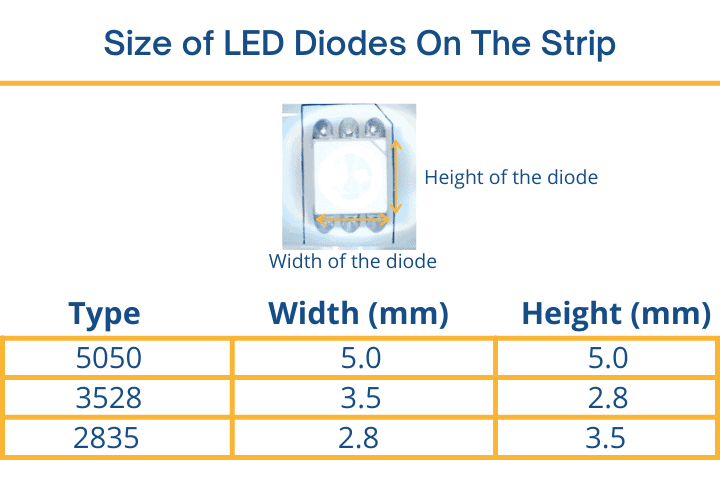
Speaking about brightness. Brighter is better, right?
Well, not necessarily. You need to consider two things, the first of which is power consumption.
A brighter strip – either due to the density or chip size – will cost more to buy and need more power.
Consider why you’re using your LED lights – if it’s just to provide a calming ambiance in your garden or to gently illuminate your porch, then you might not need to waste the money on a more costly and power-intensive strip.
The other important factor is light pollution.
Several states in the US and countries around the world have laws to prevent light trespass, which is light that shines where it is not needed or wanted, and glare, defined as excessive brightness that causes discomfort.
Suppose you buy a high-density or other bright LED strip and place it without considering your neighbors. In that case, you might be shining a light into their home when it is unwanted.
Many laws state that lights can only be placed where they are sheltered and pointing downwards to prevent light shining into nearby homes.
So before you rush off to buy the brightest light strip you can find, think about the purpose and where you’re going to place it.
Putting a bright LED strip on the underside of your porch will likely be fine, as it’ll be shining downwards only.
But choose an unnecessarily bright strip for your home, and affix it to a surface that faces a neighbor, and you could face a complaint.
Also, there is no Christmas exemption.
If you buy bright LED light strips as part of your Christmas scene and live in an area with light pollution laws, you might get in trouble.
The complaining neighbor might be a bit of a Scrooge but technically they are allowed to lodge their grievance.
How To Mount LED Strip Lights Outside Safely?
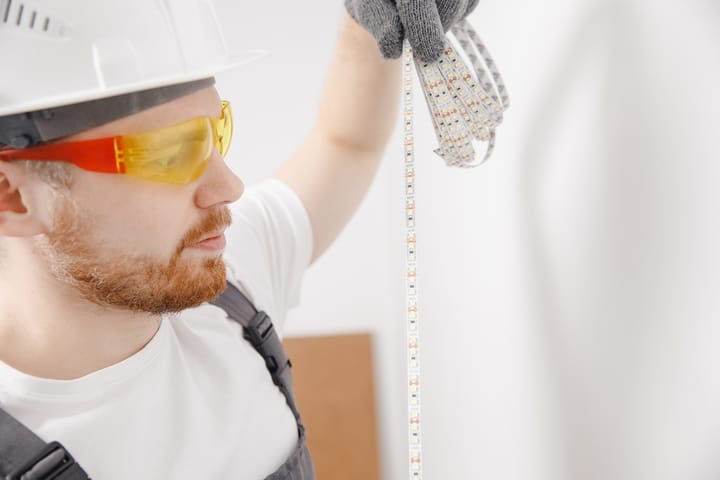
Once you have your ideal light strip for your outdoor space, it’s time to work out how best to mount it.
I will talk separately about temporary and permanent mounting since you’ll want to use different fixings for each.
Temporary Mounting
Temporary mounting for LED strip lights is best when you’re only hanging them for a short amount of time.
You might only bring out the lights for garden parties, or perhaps you’ve invested in some festive RGB light strips for Christmas as part of an epic light show.
You need something that will keep your lights in place and withstand the weather but not be so permanent that you’re stuck with the strip in place forever.
LED strip lights normally come with their own double-sided adhesive tape (Amazon). You stick one side to the surface, and then affix the strip.
However, they’re not necessarily designed for outdoor use, even if you buy an IP65 or better one designed to be waterproof.
The tape might seem fine at first, but the changing temperatures could cause the glue to soften as it warms then cools over time.
Water can also soften the glue. If water gets underneath the adhesive and freezes, it will expand and loosen the bond.
Foam mounting tape tends to be stronger, as it’s waterproof and is thicker, so it can withstand a more powerful adhesive.
If you want to remove the tape with the lights, then you’ll likely need a heat gun to clear it.
Alternatively, you could buy mounting clips.
They’ll share some of the same issues as adhesive tape – you’re essentially taping up small clips – but because there’s less surface area (you’re only taping the clips, not the entire length of light strip), then there is a slightly lower chance of the adhesive having problems.
Finally, a hot glue gun can be a potential solution.
Hot glue is weatherproof and can be picked away (or melted with a heat gun) when the time comes. You may need a lot of hot glue to hold a long strip in place, though.
There’s no guaranteed way to mount LED strips outdoors temporarily. The humidity of the climate and the temperature could make it tricky.
If you’re determined to use LED tape lights outside, but you can’t get them to stay in place with tape or temporary hooks, you might need to consider a more permanent solution.
Strip lights are discreet, so if you don’t mind them being left outdoors then you don’t need to always leave them on, and they’ll hardly be noticeable.
Permanent Mounting

Permanently mounting an LED strip outdoors is a lot easier than a temporary option. You’ve three main routes to opt for, depending on the surface.
First up is dedicated outdoor mounting tape.
This is another double-sided tape that you can find in many hardware stores or on Amazon that’s designed to be permanent.
The tape can work on most surfaces, including uneven brickwork – it’s exceptionally strong.
Alternatively, if mounting on masonry, you could drill clips into the brick.
You’ll just need to buy your hooks or clips, drill a small way into the brick and add a wall plug before inserting the fixing. Then, clip or hook the strip in place.
If mounting on a wooden porch or certain UPVC, your final option is to staple the strip light in place.
Make sure to use staples that are wider than an LED strip – most strips are around a half-inch wide, which is wider than standard staples.
Look for roofing staples (and a staple gun to match).
Final Words
There’s a lot to think about when it comes to mounting an LED strip light outside. Still, it’s an energy-efficient way to light your home and can create a wonderful atmosphere when you’re sitting on your porch or decking.
Always make sure you buy the light strip that’s right for your needs – in this case, something with an IP rating of 65 or better, and that is easy to mount in a way that won’t cause your neighbors to complain.
Have you used LED strip lights outside your home? How did you fix them in place?
Let me know in the comments below.

